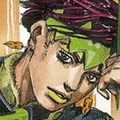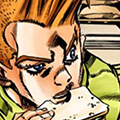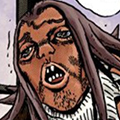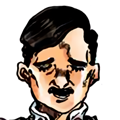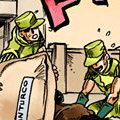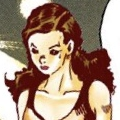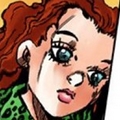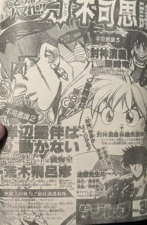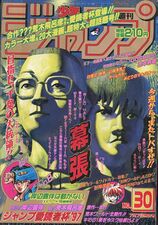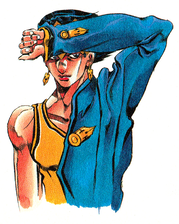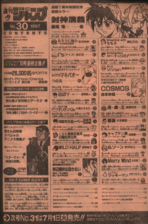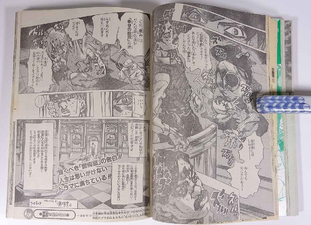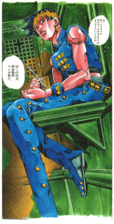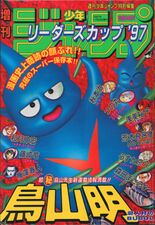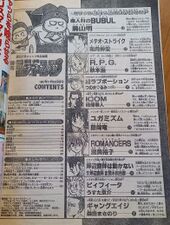Episode 16: At a Confessional (エピソード#16 懺悔室, Episōdo #16 Zange-shitsu, lit. Episode #16: Confessional) is a one-shot written and illustrated by Hirohiko Araki, and the first chapter in the titular Thus Spoke Kishibe Rohan series. It was originally created for Shonen Jump: Readers' Cup '97, which released on November 23, 1997,[3] but debuted in Weekly Shonen Jump 1997 #30 on June 24, 1997. The one-shot was also included in the aizōbon volume Under Execution, Under Jailbreak.
On August 18, 2019, an OVA adaptation by David Production was announced. The episode was screened at select Japanese theaters and was eventually released on Blu-ray and DVD on March 25, 2020.[4]
It is set to receive a live-action film adaptation releasing on May 26, 2025, as part of the TV drama adaptation of Thus Spoke Kishibe Rohan.[5]
While researching for his manga, Rohan Kishibe visits a church in Venice, Italy, where he accidentally enters the priest's side of a confessional booth and listens to a sinner's terrifying story.
Summary
Rohan Kishibe presents himself and narrates a gruesome story he heard in Italy. After an incident forcing him to pause his series Pink Dark Boy for the summer, Rohan had decided to take a vacation in Italy. In Venice, Rohan accidentally entered the priest's compartment of a confessional in the middle of his research. Shortly after, a man entered the booth and confessed his sin to Rohan, believing him to be a priest. Interested, Rohan heard out his confession. The man described his youth as a common worker. One day, a starving Asian beggar came to him begging for food. Disdainful, he forced the beggar to carry large bags of corn, eventually leading to the beggar's death. However, the beggar's ghost appeared, swearing revenge and stating that he would come back on the happiest day of his life.
Things soon looked up for the man; after creating a brand of popcorn, he became rich and eventually had a daughter with a supermodel. One day, as he and a servant watched his daughter cheerfully playing with a bag of his popcorn, the man couldn't help but think that it was the happiest moment of his life.
Suddenly, the spirit of the beggar possessed the little girl and revealed that he had assisted the man's prosperity from behind the scenes, in order to fulfill his threat of revenge. The ghost explained that he wanted fate to judge the man fairly, and thus challenged his enemy to throw a piece of popcorn in the air higher than a nearby lamppost and catch it in his mouth, each time at the clap of his hands, three times in a row. If his enemy succeeded, the spirit would leave the man forever; otherwise, the beggar would immediately cut off his head.
With luck and ingenuity, the beggar's enemy succeeded twice, but attracted a flock of pigeons hungry for popcorn. To deter them from the last toss, he lit the popcorn on fire before he threw it. But just when the popcorn began to fall, sunlight shone out from behind the clouds, making him unable to see the flame. The popcorn thus landed on his shirt, and without a second to spare, the beggar cut off his head.
And yet, the confessor survived. At the confessional, the ghosts of the beggar and the servant both appeared near him; the man had used his own servant as a body double to trick the beggar, only to incur the wrath of both as ghosts. Rohan watched the spirits follow the man as he left, vowing to never take their eyes off him again. Deciding to interview him later if given the chance, Rohan expresses some respect for a man who clung to life so desperately.
Appearances
Author's Note
露伴先生登場部分をカットして読んでみてください。香りのない食事みたいに感じてしまうでしょう。そして今となっては、この「禁止令」がなければ、露伴スピンオフ作品は以後描かなかったとも思います。何よりそういうことに感謝したい。
(Published in Weekly Shonen Jump #30, 1997)
When I was a child, my father and grandfather used to scold me by saying, "People like you should move to a deserted island," or, "I'll go ask the prison to lock you up!" (There was a prison near our house.) I thought, "I'd like to go to a deserted island," but I also thought, "Prison is so scary, please don't let me go there!" One particular rebuke he used was, "If you live your life mocking people, you'll be struck down when you are happiest." I still find it terrifying. I fear being struck down whenever I'm happy, and as I grow older, I'm becoming more and more afraid of it. I don't think I'm cheating anyone, but I still don't like it. However, I do like the main character of this work, who remains undaunted. The "Thus Spoke" part of the title means that Kishibe Rohan is not the protagonist, but instead the navigator of the story. (I'd call it a B-type work.)
(週刊少年ジャンプ 97年30号掲戴)
子供の頃、父や祖父がよくわたしを叱る時、「無人島へ行け!おまえのようなヤツは!」とか、「刑務所に頼んで入れてもらうぞ!」(家の近所に刑務所があった)とか言われて、「無人島は行ってみたいなあ」と思ったが、「刑務所はすごく恐ろしくて、カンベンしてくれえ」と思った。そんな叱りの言葉の中に「普段、人をあざむいて生活していると一番幸福な時にバチがあたるぞ」というのがあって、それはいまだに恐ろしい。ハッピーって時に突き落とされるのが、ヤパイって感じがあって、大人になるにしたがって恐怖の度合いが増して来てるんですけど。別に人をだましてはいないと思うんだけど、イヤな感じ。でも、それでもヘコたれない本作品の主人公は好き。タイトルの「動かない」というのは、岸辺露伴は主人公ではなく、物語のナピゲーターですよ、という意味。(作品タイプで言うとB)
Author's Comments
Creation & Development
During the time period this one-shot was written, Weekly Shonen Jump's editorial department restricted the publication of side stories for pre-existing ongoing Jump titles, which prompted Araki to find a workaround. The resulting concept of Rohan narrating a short story was largely inspired by the 1950's TV show, Alfred Hitchcock Presents,[6] and the series's name, Rohan Kishibe Does Not Move (岸辺露伴は動かない), was derived from the fact that Rohan is not the main protagonist in this one-shot, but rather a "navigator" or onlooker of the story.[7]
Gallery
Trivia
- In the one-shot's Weekly Shonen Jump and Readers' Cup '97 publications, Rohan Kishibe himself is credited as the author of the work, with Hirohiko Araki being listed merely as an illustrator. Additionally, the author's comments in both magazines are written from Rohan's perspective as well.
- Following the one-shot's initial publication in Weekly Shonen Jump, the ending pages were heavily altered for Readers' Cup '97 and all subsequent volumizations: the single page revealing Mizuo's ghost was extended to take up two pages with additional drawings and dialogue, and the ending page was expanded into a full two-page spread.
References
